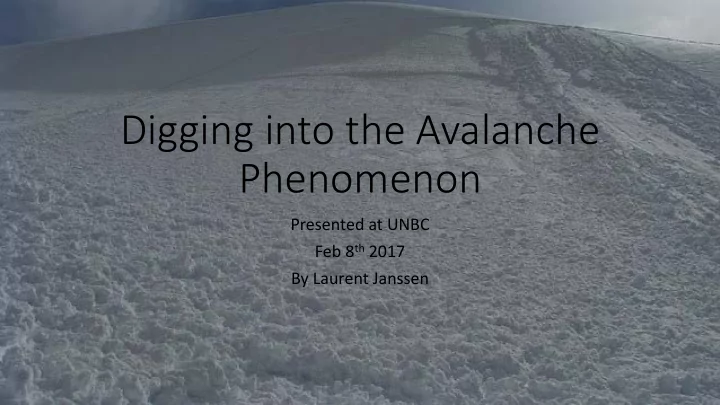

Digging into the Avalanche Phenomenon Presented at UNBC Feb 8 th 2017 By Laurent Janssen
Scope of this presentation • Basic knowledge of the Avalanche Phenomenon • Basic knowledge of Avalanche Terrain Morphology • Basic knowledge of the life of a snowflake • Better appreciate the complexity of the Avalanche Phenomena • I will try not to get into backcountry avalanche safety.
Avalanche definition : • Oxford dictionaries: A mass of snow, ice, and rocks falling rapidly down a mountainside. (en.oxforddictionaries.com) • Dictionary.com: a large mass of snow, ice, etc., detached from a mountain slope and sliding or falling suddenly downward. (www.dictionary.com) • Oxford dictionaries: A sudden arrival or occurrence of something in overwhelming quantities. • Origin of the word Avalanche: Late 18th century: from French, alteration of the Alpine dialect word lavanche (of unknown origin), influenced by avaler descend; compare with Italian valanga. (en.oxforddictionaries.com)
The Avalanche on Television!
The common avalanche.
Canadian Snow Avalanche Size Classification
Size 1 Relatively harmless to people Typically: • Mass: 10 tonnes • Run: 10 meters • Force: 1 kilopascal
Size 2 Could bury, injure or kill a person Typically: • Mass: 100 tonnes • Run: 100 meters • Force: 10 kilopascals
Size 3 Could bury or destroy a car, damage a truck, destroy a wood frame house or break a few trees Typically: • Mass: 1,000 tonnes • Run: 1,000 meters • Force: 100 kilopascals
Size 4 Could destroy a railway car, large truck, several buildings or up to 4 hectares of forest. Typically: • Mass: 10,000 tonnes • Run: 2,000 meters • Force: 500 kilopascals
Size 5 Catastrophic Typically: • Mass: 100,000 tonnes • Run: 3,000 metres • Force: 1,000 kilopascals Huascaran avalanche in Peru, May 31, 1970
The Avalanche Triangle The 3 ingredients necessary to produce an avalanche Avalanche Trigger
Slope • An avalanche happens when gravitational force becomes greater then friction force.
Trigger Natural trigger such as: • Extra load : Precipitation (snow or rain) • Wind : transporting snow, therefor creating extra load • Rapid warming : radiation (sun), weather (frontal) • Earthquake • Cornice fall Artificial trigger such as: • Skier, snowboarder, snowmobiler, snowshoer…. • Explosives
Unstable snow • Snow with little or no cohesion, no strength • Snow pack layering
Avalanche Terrain Morphology • The classic avalanche path
Wind Effect • Lee aspect : opposite aspect of the wind direction • Cross loaded aspect : perpendicular aspect to wind direction
Solar aspect • The angle is everything
Elevation • The air normally gets cooler as we get higher (in the Troposphere), which will have an influence on the snowpack and precipitation type…
Avalanche Terrain Exposure Scale • Simple Terrain • Challenging Terrain • Complex Terrain
Simple terrain
Challenging terrain
Complex terrain
Avalanche Character or type As define by Avalanche Canada Slab avalanches Loose avalanches • Wind slab Loose wet • Loose dry • Wet slab • • Storm slab • Persistent slab Cornice fall • Deep persistent slab
Slab Avalanches
Loose Avalanches (sluff)
Cornice fall
The life of a snowflake
They form in the atmosphere • No snowflakes are the same : The exact shape of the final snow crystal is determined by the precise path it took through the clouds. But the six arms all took the same path, and so each experienced the same changes at the same times
The most stable form of ice crystal
Metamorphic processes once on the ground • Settlement • Rounding • Faceting • Melting and freezing (crust formation)
Settlement
These metamorphic processes are more efficient at warmer temperatures Clausius Clapayron Equation
Rounding
Faceting
Melting and freezing (crust formation)
Surface hoar formation
• Clear sky • Calm or light winds (about 3 mph is best) • Open slope exposed to a clear sky (trees or clouds can radiate their own heat and disrupt the process) • Humid air
Thank you!
References • Avalanche Canada: www.avalanche.ca • Oxford dictionary: en.oxforddictionaries.com • Dictionary.com: www.dictionary.com • McClung and Schaerer, D.McC. and P.S., 2006, The Avalanche Handbook 3 rd ed, Seattle, The Mountaineers Books. • Avy Snacks, Sherpa Cinema • www.avalanches.org • www.snowcrystals.com • www.ngdc.noaa.gov/hazardimages
Recommend
More recommend